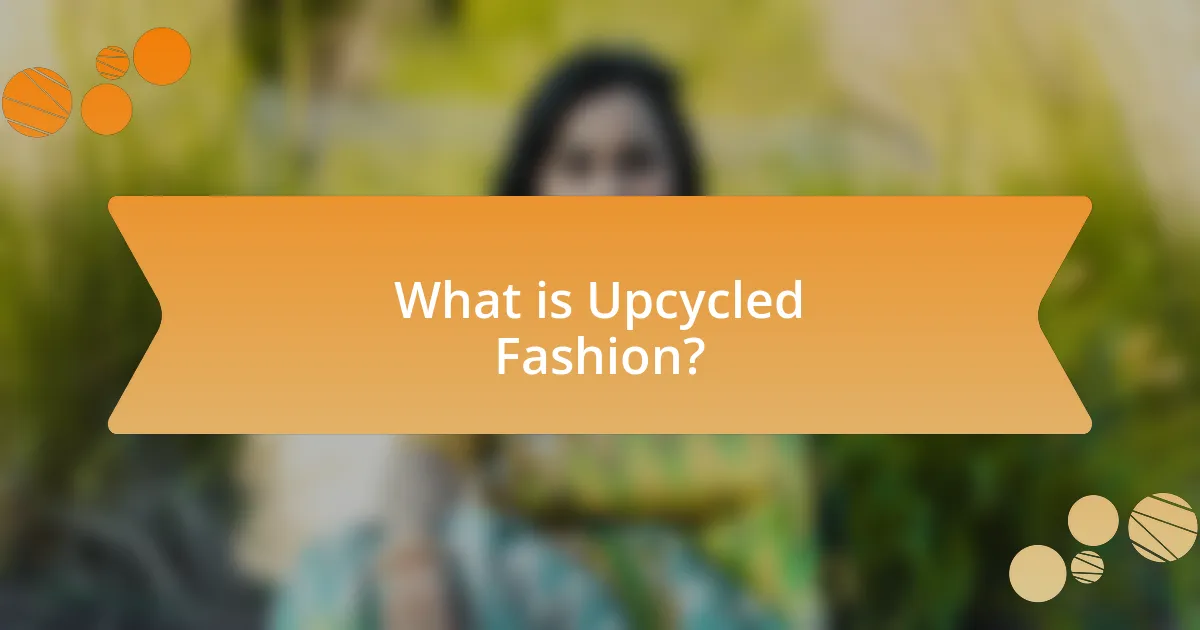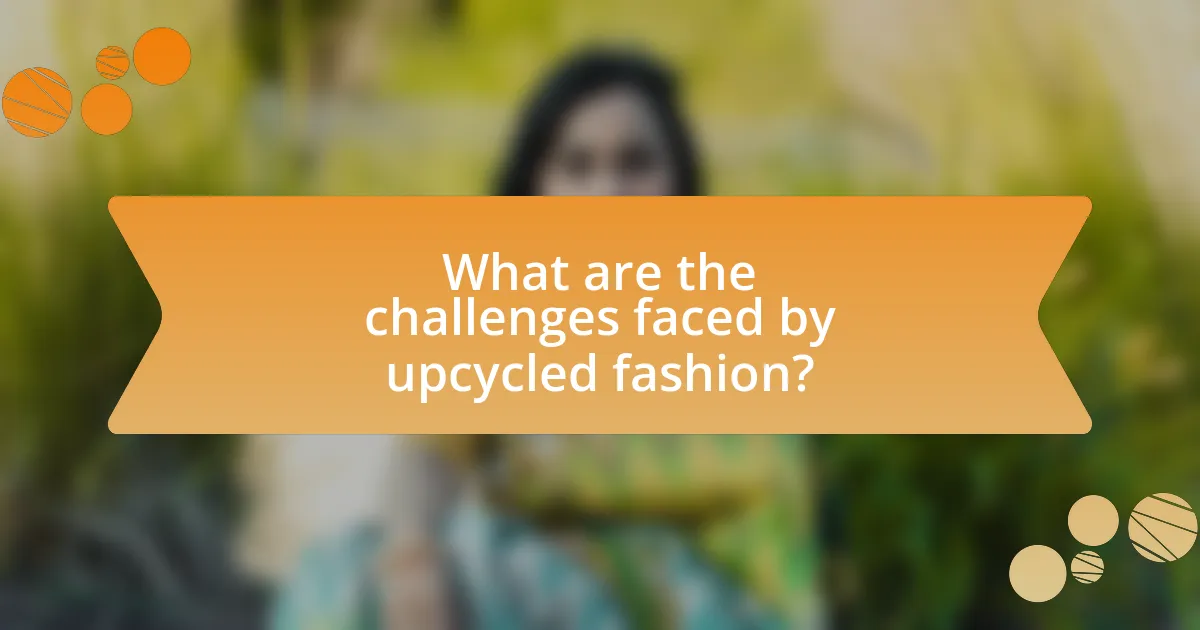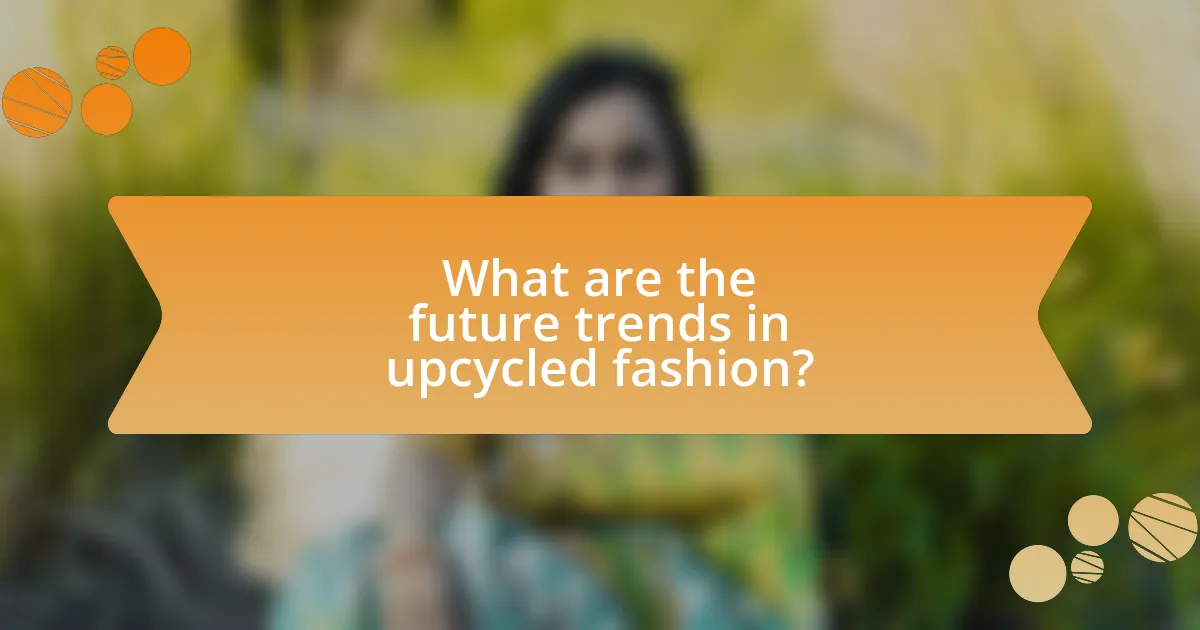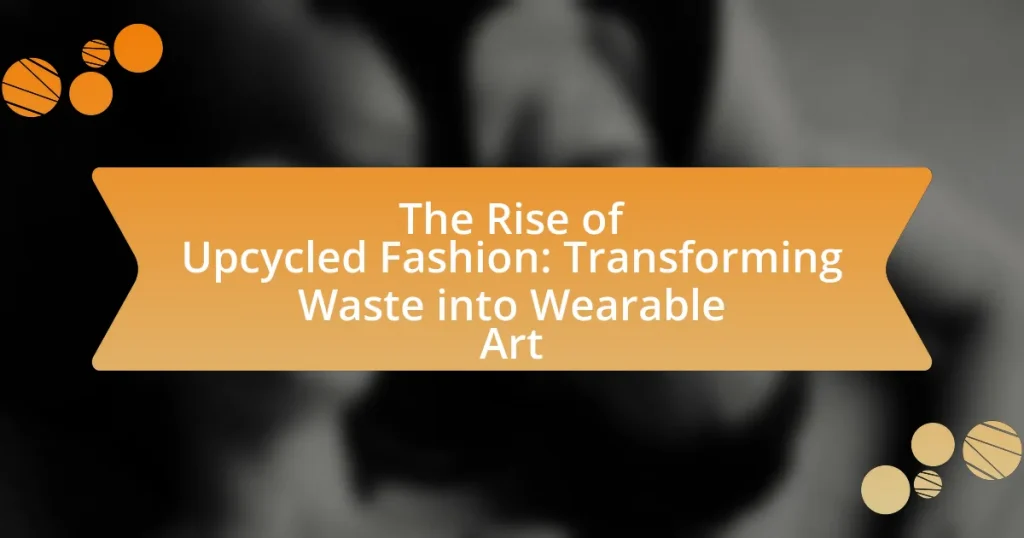Upcycled fashion is the practice of repurposing discarded materials and garments into new clothing and accessories, significantly reducing waste and promoting sustainability within the fashion industry. This article explores the differences between upcycled and traditional fashion, the materials commonly used, and the process of transforming garments. It also examines the growing popularity of upcycled fashion driven by consumer awareness, the environmental benefits it provides, and the challenges faced by designers in sourcing materials. Additionally, the article highlights key players in the movement, the role of technology and education, and practical tips for consumers to embrace upcycled fashion.

What is Upcycled Fashion?
Upcycled fashion is the practice of repurposing discarded materials or garments into new clothing or accessories, thereby reducing waste and promoting sustainability. This approach not only minimizes the environmental impact of the fashion industry but also encourages creativity and individuality in design. According to a report by the Ellen MacArthur Foundation, the fashion industry is responsible for 92 million tons of waste annually, highlighting the importance of upcycling as a solution to this pressing issue.
How does upcycled fashion differ from traditional fashion?
Upcycled fashion differs from traditional fashion primarily in its use of pre-existing materials to create new garments, whereas traditional fashion typically relies on new textiles and resources. Upcycled fashion emphasizes sustainability by repurposing discarded items, reducing waste, and minimizing environmental impact, while traditional fashion often contributes to resource depletion and pollution through mass production processes. For example, upcycled fashion can involve transforming old clothing or fabric scraps into unique pieces, which not only conserves resources but also promotes creativity and individuality in design.
What materials are commonly used in upcycled fashion?
Common materials used in upcycled fashion include discarded textiles, vintage clothing, and surplus fabric. These materials are repurposed to create new garments, reducing waste and promoting sustainability. For instance, according to a report by the Ellen MacArthur Foundation, the fashion industry generates over 92 million tons of waste annually, highlighting the importance of utilizing existing materials to mitigate environmental impact. Additionally, upcycled fashion often incorporates materials like denim, leather, and even plastic bottles, showcasing creativity while addressing the issue of textile waste.
How is the process of upcycling garments executed?
The process of upcycling garments is executed by creatively transforming discarded or unused clothing into new, functional pieces. This involves several steps: first, selecting garments that are no longer worn or damaged; second, deconstructing these items to salvage usable materials; third, redesigning and reconstructing them into new clothing or accessories; and finally, finishing the pieces with appropriate techniques such as sewing, dyeing, or embellishing. Upcycling not only reduces textile waste but also promotes sustainability in fashion, as it repurposes materials that would otherwise contribute to landfill overflow.
Why is upcycled fashion gaining popularity?
Upcycled fashion is gaining popularity due to increasing consumer awareness of environmental issues and the desire for sustainable alternatives to fast fashion. This trend is driven by a growing recognition that the fashion industry significantly contributes to waste and pollution, with an estimated 92 million tons of textile waste generated annually. Additionally, upcycled fashion offers unique, one-of-a-kind pieces that appeal to consumers seeking individuality and creativity in their wardrobes. The combination of environmental consciousness and the appeal of distinctive styles has led to a surge in interest and demand for upcycled clothing.
What environmental benefits does upcycled fashion provide?
Upcycled fashion significantly reduces waste by repurposing discarded materials, thereby minimizing landfill contributions. This practice conserves resources, as it requires less energy and water compared to producing new garments from raw materials. For instance, the Ellen MacArthur Foundation reports that the fashion industry is responsible for 92 million tons of waste annually, and upcycling can help mitigate this by transforming waste into valuable products. Additionally, upcycled fashion decreases the demand for new textiles, which often involve harmful manufacturing processes that contribute to pollution and resource depletion.
How does upcycled fashion contribute to sustainability?
Upcycled fashion contributes to sustainability by reducing waste and minimizing the demand for new resources. This practice involves repurposing discarded materials into new clothing items, which helps divert textiles from landfills. According to the Environmental Protection Agency, in 2018, approximately 11.3 million tons of textile waste were generated in the United States alone, highlighting the significant impact of upcycling in addressing this issue. By transforming waste into wearable art, upcycled fashion not only conserves resources but also promotes a circular economy, where materials are reused and recycled, thereby reducing the overall environmental footprint of the fashion industry.
Who are the key players in the upcycled fashion movement?
Key players in the upcycled fashion movement include brands like Re/Done, which repurposes vintage denim, and Patagonia, known for its commitment to sustainability and recycling materials. Additionally, designers such as Christopher Raeburn and brands like Eileen Fisher have made significant contributions by incorporating upcycled materials into their collections. These entities are recognized for their innovative approaches to reducing waste and promoting sustainable practices in the fashion industry.
What role do designers play in promoting upcycled fashion?
Designers play a crucial role in promoting upcycled fashion by creatively transforming waste materials into stylish garments, thereby raising awareness about sustainability in the fashion industry. They utilize innovative techniques to repurpose discarded textiles, which not only reduces waste but also challenges conventional fashion norms. For instance, designers like Stella McCartney and Eileen Fisher have successfully integrated upcycled materials into their collections, demonstrating that eco-friendly fashion can be both aesthetically pleasing and commercially viable. This approach not only attracts environmentally conscious consumers but also inspires other designers to adopt sustainable practices, contributing to a broader cultural shift towards upcycled fashion.
How do consumers influence the growth of upcycled fashion?
Consumers significantly influence the growth of upcycled fashion by driving demand for sustainable and unique clothing options. Their increasing awareness of environmental issues and desire for individuality lead to a preference for upcycled products, which are often perceived as more eco-friendly and exclusive compared to mass-produced items. According to a 2021 survey by McKinsey & Company, 67% of consumers consider sustainability when making a purchase, highlighting the impact of consumer values on market trends. This shift in consumer behavior encourages brands to innovate and expand their upcycled fashion offerings, further propelling the industry’s growth.

What are the challenges faced by upcycled fashion?
Upcycled fashion faces several challenges, including sourcing quality materials, consumer perception, and scalability. Sourcing quality materials can be difficult as upcycled fashion relies on discarded items, which may vary in availability and condition. Consumer perception often presents a hurdle, as some individuals may view upcycled items as inferior or less desirable compared to new products. Scalability is another significant challenge, as the production processes for upcycled fashion can be labor-intensive and may not easily accommodate large-scale manufacturing, limiting market reach. These challenges hinder the growth and acceptance of upcycled fashion in the mainstream market.
What obstacles do designers encounter in sourcing materials?
Designers encounter several obstacles in sourcing materials for upcycled fashion, primarily including limited availability, inconsistent quality, and logistical challenges. Limited availability arises because upcycled materials often depend on waste streams that can be unpredictable, making it difficult for designers to secure a steady supply. Inconsistent quality is another significant issue, as the condition of reclaimed materials can vary widely, impacting the final product’s durability and aesthetic. Logistical challenges, such as transportation and storage of diverse materials, further complicate the sourcing process, often leading to increased costs and time delays. These obstacles highlight the complexities designers face in creating sustainable fashion from waste.
How does the quality of upcycled materials affect the final product?
The quality of upcycled materials significantly impacts the durability, aesthetic appeal, and overall functionality of the final product. High-quality upcycled materials contribute to a more robust and visually appealing item, while lower-quality materials may lead to a product that is less durable and less attractive. For instance, a study published in the Journal of Cleaner Production found that products made from high-quality upcycled textiles exhibited better performance in terms of wear resistance and color retention compared to those made from lower-quality sources. This correlation underscores the importance of material selection in upcycled fashion, as it directly influences consumer satisfaction and product longevity.
What are the limitations in consumer perception of upcycled fashion?
Consumer perception of upcycled fashion is limited by several factors, including misconceptions about quality, aesthetic appeal, and price. Many consumers associate upcycled items with lower quality due to their origins from discarded materials, leading to skepticism about durability and craftsmanship. Additionally, the unique and often unconventional designs of upcycled fashion may not align with mainstream fashion trends, causing hesitation among consumers who prioritize traditional styles. Price perception also plays a role; consumers may expect upcycled items to be cheaper, despite the labor-intensive processes involved in creating them, which can lead to undervaluation of the product. These limitations are supported by studies indicating that consumer attitudes towards sustainability often conflict with their preferences for conventional fashion standards.
How can upcycled fashion overcome these challenges?
Upcycled fashion can overcome challenges by promoting sustainable practices that reduce waste and resource consumption. By utilizing discarded materials, upcycled fashion minimizes the demand for new textiles, which is responsible for significant environmental degradation; for instance, the fashion industry contributes to 10% of global carbon emissions. Additionally, upcycled fashion fosters creativity and innovation, allowing designers to create unique pieces that stand out in a saturated market. This uniqueness can attract consumers who are increasingly seeking sustainable and ethical options, as evidenced by a 2021 survey indicating that 66% of consumers are willing to pay more for sustainable brands. Thus, upcycled fashion not only addresses environmental concerns but also aligns with shifting consumer preferences towards sustainability.
What strategies can designers implement to enhance material sourcing?
Designers can enhance material sourcing by prioritizing local and sustainable suppliers, which reduces transportation emissions and supports the local economy. By establishing partnerships with local artisans and businesses, designers can access unique materials that align with upcycled fashion principles. Additionally, implementing a systematic inventory management approach allows designers to track available materials efficiently, minimizing waste and maximizing resource utilization. Research indicates that sourcing materials locally can decrease carbon footprints by up to 50%, reinforcing the environmental benefits of this strategy.
How can marketing improve consumer acceptance of upcycled fashion?
Marketing can improve consumer acceptance of upcycled fashion by effectively communicating its environmental benefits and unique value proposition. By highlighting the reduction of waste and the sustainable practices involved in upcycling, marketing campaigns can resonate with eco-conscious consumers. For instance, a study by the Ellen MacArthur Foundation indicates that the fashion industry is responsible for 92 million tons of waste annually, emphasizing the need for sustainable alternatives. Additionally, showcasing the creativity and individuality of upcycled pieces can attract consumers seeking unique fashion items, as evidenced by the growing popularity of brands like Reformation and Patagonia, which have successfully integrated sustainability into their marketing strategies.

What are the future trends in upcycled fashion?
Future trends in upcycled fashion include increased use of technology for design and production, a focus on circular economy principles, and greater consumer demand for sustainable practices. Technology, such as 3D printing and digital design tools, allows designers to create innovative pieces from waste materials efficiently. The circular economy emphasizes reusing materials and reducing waste, which aligns with the growing consumer awareness of environmental issues; for instance, a report by McKinsey highlights that 67% of consumers consider sustainability when making fashion purchases. Additionally, collaborations between brands and artists to create unique upcycled collections are expected to rise, enhancing the artistic value of upcycled garments.
How is technology influencing the upcycled fashion industry?
Technology is significantly influencing the upcycled fashion industry by enabling innovative design processes and enhancing material sourcing. Advanced software tools allow designers to visualize and manipulate materials digitally, facilitating creative transformations of waste into fashionable items. For instance, 3D modeling software helps in prototyping upcycled garments, reducing waste during the design phase. Additionally, technologies like laser cutting and digital printing streamline the production process, making it easier to work with reclaimed materials. According to a report by the Ellen MacArthur Foundation, the integration of technology in fashion can reduce waste by up to 30%, showcasing its potential impact on sustainability within the upcycled fashion sector.
What innovations are emerging in the upcycling process?
Innovations emerging in the upcycling process include the use of advanced technologies such as 3D printing and digital design software, which enable designers to create unique, customized pieces from waste materials. Additionally, the integration of artificial intelligence in inventory management helps brands optimize the sourcing of discarded textiles, reducing waste further. Research indicates that upcycled fashion can reduce carbon emissions by up to 80% compared to traditional manufacturing methods, highlighting the environmental benefits of these innovations.
How can digital platforms support upcycled fashion brands?
Digital platforms can support upcycled fashion brands by providing a marketplace for their products, enhancing visibility, and facilitating community engagement. These platforms allow brands to reach a broader audience, which is crucial for niche markets like upcycled fashion, where consumer awareness and demand are growing. For instance, platforms like Etsy and Depop have successfully enabled small upcycled fashion brands to showcase their unique offerings, leading to increased sales and brand recognition. Additionally, social media channels like Instagram and TikTok serve as powerful tools for storytelling and marketing, allowing brands to share their sustainability missions and connect with environmentally conscious consumers. According to a report by McKinsey & Company, the online fashion market is projected to grow significantly, indicating that digital platforms are essential for the sustainability and growth of upcycled fashion brands.
What role does education play in the future of upcycled fashion?
Education plays a crucial role in the future of upcycled fashion by equipping individuals with the knowledge and skills necessary to innovate and implement sustainable practices. Through educational programs focused on design, sustainability, and textile recycling, students learn how to creatively repurpose materials, reducing waste and promoting environmental consciousness. For instance, institutions like the London College of Fashion offer courses specifically on sustainable fashion, highlighting the importance of upcycling in the curriculum. This educational foundation fosters a new generation of designers who prioritize eco-friendly methods, thereby driving the growth and acceptance of upcycled fashion in the industry.
How can awareness campaigns promote upcycled fashion?
Awareness campaigns can promote upcycled fashion by educating consumers about its environmental benefits and encouraging sustainable purchasing habits. These campaigns highlight the reduction of textile waste, as the fashion industry contributes to 92 million tons of waste annually, according to the United Nations. By showcasing the creativity and uniqueness of upcycled garments, awareness campaigns can shift consumer perceptions, making upcycled fashion more appealing. Additionally, partnerships with influencers and social media platforms can amplify the message, reaching a broader audience and fostering a community that values sustainability.
What educational programs are available for aspiring upcycled fashion designers?
Aspiring upcycled fashion designers can pursue various educational programs that focus on sustainable fashion and design principles. Institutions such as the Fashion Institute of Technology (FIT) offer courses specifically in sustainable fashion design, which includes upcycling techniques. Additionally, programs at Central Saint Martins in London emphasize innovative design practices, including the use of recycled materials. The University of the Arts London also provides a Master’s program in Fashion and the Environment, which covers upcycling as a key component of sustainable design. These programs equip students with the necessary skills and knowledge to create fashion from waste materials, aligning with the growing trend of upcycled fashion.
What practical tips can consumers follow to embrace upcycled fashion?
Consumers can embrace upcycled fashion by actively seeking out clothing made from repurposed materials. This involves shopping at thrift stores, vintage shops, or brands that specialize in upcycled garments, which often utilize discarded textiles to create new items. Additionally, consumers can participate in clothing swaps or DIY projects to transform old garments into new styles, thereby reducing waste and promoting sustainability. According to a report by the Ellen MacArthur Foundation, the fashion industry is responsible for significant waste, and upcycling can help mitigate this impact by extending the lifecycle of clothing.



